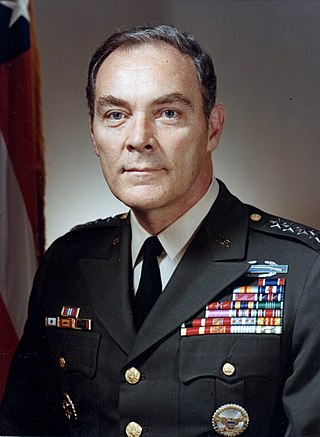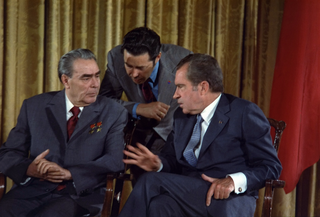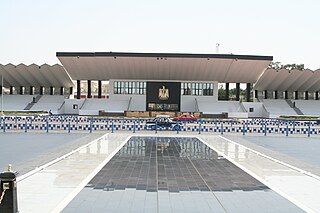Related Research Articles

Henry Alfred Kissinger was an American diplomat, political scientist, geopolitical consultant, and politician who served as the United States secretary of state and national security advisor in the presidential administrations of Richard Nixon and Gerald Ford between 1969 and 1977.

Muhammad Anwar es-Sadat was an Egyptian politician and military officer who served as the third president of Egypt, from 15 October 1970 until his assassination by fundamentalist army officers on 6 October 1981. Sadat was a senior member of the Free Officers who overthrew King Farouk in the Egyptian Revolution of 1952, and a close confidant of President Gamal Abdel Nasser, under whom he served as Vice President twice and whom he succeeded as president in 1970. In 1978, Sadat and Menachem Begin, Prime Minister of Israel, signed a peace treaty in cooperation with United States President Jimmy Carter, for which they were recognized with the Nobel Peace Prize.

The Watergate scandal was a significant political controversy in the United States during the presidency of Richard Nixon from 1972 to 1974, ultimately resulting in Nixon's resignation. It originated from attempts by the Nixon administration to conceal its involvement in the June 17, 1972, break-in at the Democratic National Committee headquarters located in the Watergate Office Building in Washington, D.C.

Alexander Meigs Haig Jr. was United States secretary of state under president Ronald Reagan and White House chief of staff under presidents Richard Nixon and Gerald Ford. Prior to and in between these cabinet-level positions, he was a general in the U.S. Army, serving first as the vice chief of staff of the Army and then as Supreme Allied Commander Europe. In 1973, Haig became the youngest four-star general in the Army's history.

The Strategic Arms Limitation Talks (SALT) were two rounds of bilateral conferences and corresponding international treaties involving the United States and the Soviet Union. The Cold War superpowers dealt with arms control in two rounds of talks and agreements: SALT I and SALT II.

Elliot Lee Richardson was an American lawyer and Republican politician. As a member of the cabinets of Richard Nixon and Gerald Ford between 1970 and 1977, Richardson is one of two men in United States history to hold four cabinet positions. As United States Attorney General, Richardson played a prominent role in the Watergate scandal when he resigned in protest against President Nixon's order to fire special prosecutor Archibald Cox. His resignation precipitated a crisis of confidence in Nixon which ultimately led to the president's resignation.

Détente is the relaxation of strained relations, especially political ones, through verbal communication. The diplomacy term originates from around 1912, when France and Germany tried unsuccessfully to reduce tensions.
The Jackson–Vanik amendment to the Trade Act of 1974 is a 1974 provision in United States federal law intended to affect U.S. trade relations with countries with non-market economies that restrict freedom of Jewish emigration and other human rights. The amendment is contained in the Trade Act of 1974 which passed both houses of the United States Congress unanimously, and signed by President Gerald Ford into law, with the adopted amendment, on January 3, 1975. Over time, a number of countries were granted conditional normal trade relations subject to annual review, and a number of countries were liberated from the amendment.

Gerald Ford's tenure as the 38th president of the United States began on August 9, 1974, upon the resignation of president Richard Nixon, and ended on January 20, 1977. Ford, a Republican from Michigan, had been appointed vice president since December 6, 1973, following the resignation of Spiro Agnew from that office. Ford was the only person to serve as president without being elected to either the presidency or the vice presidency. His presidency ended following his narrow defeat in the 1976 presidential election to Democrat Jimmy Carter, after a period of 895 days in office.

The Richard Nixon Presidential Library and Museum is the presidential library and burial site of Richard Milhous Nixon, the 37th president of the United States (1969–1974), and his wife Pat Nixon.

The Watergate scandal refers to the burglary and illegal wiretapping of the headquarters of the Democratic National Committee, in the Watergate complex by members of President Richard Nixon's re-election campaign, and the subsequent cover-up of the break-in resulting in Nixon's resignation on August 9, 1974, as well as other abuses of power by the Nixon White House that were discovered during the course of the scandal.

Gerald Rudolph Ford Jr. was an American politician who served as the 38th president of the United States from 1974 to 1977. He previously served as the leader of the Republican Party in the U.S. House of Representatives from 1965 to 1973, and as the 40th vice president under President Richard Nixon from 1973 to 1974. Ford succeeded to the presidency when Nixon resigned in 1974, but was defeated for election to a full term in 1976. Ford is the only person to serve as president and vice president without being elected to either office.

SAM 27000 was the second of two Boeing VC-137C United States Air Force aircraft that were specifically configured and maintained for the use of the president of the United States. It used the call sign Air Force One when the president was on board, and at other times it used the call sign SAM 27000, with SAM indicating 'Special Air Mission.' The VC-137C serial number 72-7000 was a customized version of the Boeing 707 which entered service during the Nixon administration in 1972. It served all US presidents until George W. Bush and was retired in 2001. It is now on display at the Ronald Reagan Presidential Library.

On 6 October 1981, Anwar Sadat, the 3rd President of Egypt, was assassinated during the annual victory parade held in Cairo to celebrate Operation Badr, during which the Egyptian Army had crossed the Suez Canal and taken back the Sinai Peninsula from Israel at the beginning of the Yom Kippur War. The assassination was undertaken by members of the Egyptian Islamic Jihad. Although the motive has been debated, Sadat's assassination likely stemmed from Arab nationalists who opposed Sadat's peace initiative with Israel and the United States relating to the Camp David Accords.

The Vladivostok Summit Meeting on Arms Control was a two-day summit held on November 23 and 24, 1974, in Vladivostok, Primorsky Krai, Russia, for the purpose of extending arms control provisions between the Soviet Union and the United States. After a series of talks between American President Gerald Ford and Soviet Foreign Minister Andrei Gromyko in Washington and American Secretary of State Henry Kissinger's visit to Moscow, Ford traveled to Vladivostok to meet with Soviet General Secretary Leonid Brezhnev directly. The two heads of state agreed to terms that would limit both nations an "equal aggregate number" of various weapons, including strategic nuclear delivery vehicles (SNDVs), intercontinental ballistic missiles (ICBMs), and submarine-launched ballistic missiles (SLBMs) fitted with multiple independently targetable reentry vehicles (MIRVs).

Viktor Mikhailovich Sukhodrev was a Soviet and Russian diplomat and translator, known for being a personal interpreter for Soviet leaders Nikita Khrushchev, Leonid Brezhnev and Mikhail Gorbachev, as well as high-ranking Soviet politicians including Alexei Kosygin, Andrei Gromyko, Anastas Mikoyan, and Frol Kozlov.

Ten United States presidents have made presidential visits to the Middle East. The first trips by an incumbent president to countries in the Middle East were those by Franklin D. Roosevelt, and were an offshoot of Allied diplomatic interactions during World War II. To date, 16 visits have been made to Egypt, 12 to Saudi Arabia, 11 to Israel, six to both Iraq, Jordan and Turkey, four to Iran, three to the Palestinian Territories, two to both Kuwait and Syria, one to Bahrain, Georgia, Oman, Qatar, and to the United Arab Emirates. No incumbent American president has yet visited Armenia, Azerbaijan, Cyprus, Lebanon, and Yemen.
Gerald Ford was the 38th president of the United States, serving from 1974 to 1977. After his tenure's end, Ford was active in the public sphere, traveling, writing a memoir, and voicing his opinion about contemporary issues within the United States and abroad.

The United States foreign policy during the 1974–1977 presidency of Gerald Ford was marked by efforts to de-escalate the Cold War. Ford focused on maintaining stability and promoting détente with the Soviet Union. One of Ford's key foreign policy achievements was the signing of the Helsinki Accords in 1975. The accords were a series of agreements between the US, Soviet Union, and other European countries that aimed to promote human rights, economic cooperation, and peaceful relations between East and West. Ford met with Soviet leader Leonid Brezhnev several times, and the two countries signed the Strategic Arms Limitation Talks in 1979, which aimed to limit the number of nuclear weapons held by the two superpowers.
References
- ↑ Kasprak, Alex (November 2, 2017). "Is This Time Magazine Cover About 'Global Cooling'?". Snopes.
| Previous | Lists of covers of Time magazine | Next |
|---|---|---|
| 1960s | 1970s | 1980s |